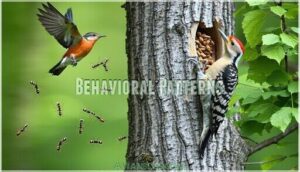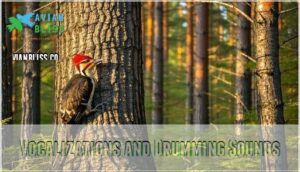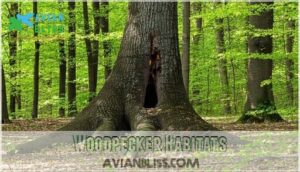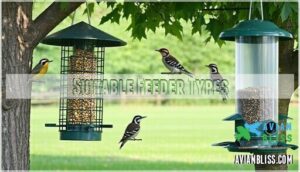This site is supported by our readers. We may earn a commission, at no cost to you, if you purchase through links.

The Red-bellied Woodpecker dominates suburban feeders, while the striking Red-headed Woodpecker prefers open woodlands.
Tiny Downy Woodpeckers and their larger cousins, Hairy Woodpeckers, frequent dead branches and suet feeders.
Yellow-bellied Sapsuckers create neat rows of holes in tree bark, and Northern Flickers often forage on the ground for ants.
The magnificent Pileated Woodpecker, Missouri’s largest at crow-size, excavates rectangular cavities in mature forests.
Each species shows distinct field marks, drumming patterns, and habitat preferences that make identification straightforward once you know their secrets.
Table Of Contents
- Key Takeaways
- Missouri Woodpecker Species
- Woodpecker Identification
- Woodpecker Habitats
- Attracting Woodpeckers
- Woodpecker Conservation
- Frequently Asked Questions (FAQs)
- What kind of woodpeckers are in Missouri?
- Are woodpeckers good to have in your yard?
- What bird looks like a woodpecker but isn’t?
- What does it mean when you see a woodpecker is pecking a tree?
- Are there woodpeckers in Missouri?
- Are red-bellied woodpeckers common in Missouri?
- Are there Downy woodpeckers in Missouri?
- Where do woodpeckers live?
- What is the largest woodpecker in Missouri?
- Are pileated woodpeckers rare in Missouri?
- Conclusion
Key Takeaways
- You’ll find seven distinct woodpecker species in Missouri, ranging from the tiny 6.1-inch Downy Woodpecker to the massive 17.5-inch Pileated Woodpecker, with six species staying year-round and Yellow-bellied Sapsuckers migrating through seasonally.
- You can identify each species by their unique field marks—Red-bellied Woodpeckers have peachy-red caps and striped backs, Red-headed Woodpeckers sport striking crimson heads with white bodies, and Pileated Woodpeckers create distinctive rectangular excavation holes in mature forests.
- You’ll attract woodpeckers to your yard by offering high-energy foods like suet, sunflower seeds, and peanuts in sturdy feeders, while maintaining dead trees or snags and providing fresh water sources positioned 3-6 feet high near trees.
- You can support woodpecker conservation by participating in citizen science programs like eBird surveys and Christmas Bird Counts, since species like Red-headed Woodpeckers have declined 56% since 1966 due to habitat loss and urban development.
Missouri Woodpecker Species
You’ll encounter seven distinct woodpecker species across Missouri’s diverse forest ecosystems, ranging from the diminutive Downy Woodpecker at 6.1 inches to the impressive Pileated Woodpecker measuring 17.5 inches in length.
From tiny Downy to mighty Pileated—Missouri’s forests host seven remarkable woodpecker species waiting to be discovered.
Six of these species maintain year-round residency in the state, while the Yellow-bellied Sapsucker migrates through Missouri during seasonal shifts, creating opportunities for observation throughout different times of the year.
Red-bellied Woodpecker
You’ll spot Red-bellied Woodpeckers by their distinctive peachy-red caps and black-white striped backs throughout Missouri’s woodlands.
Their woodpecker diet includes insects, nuts, and suet from backyard feeders.
These missouri woodpecker species measure 9.4 inches with impressive beak strength for excavating nesting habits in dead trees.
Redbellied Woodpecker feather care involves frequent preening to maintain their striking plumage patterns.
Red-headed Woodpecker
You’ll recognize Missouri’s Red-headed Woodpecker by its striking crimson head contrasting against its pure white body and black wings.
This distinctive woodpecker species displays unique flight patterns with undulating swoops between trees.
Their nesting habits involve excavating cavities in dead wood, while their varied woodpecker diet includes insects, nuts, and fruits.
Feather care involves regular preening to maintain their bold plumage.
The conservation of woodpeckers like the Red-headed Woodpecker relies on understanding woodpecker habitat needs.
Downy Woodpecker
You’ll find North America’s smallest woodpecker species right in your Missouri backyard.
The Downy Woodpecker measures just 6.1 inches with distinctive black-and-white plumage and males sporting red patches.
Their impressive beak strength enables precise tree climbing while accessing insects.
These missouri bird species maintain excellent feather care year-round.
Downy woodpecker identification becomes easier recognizing their high-pitched calls and preference for woodpecker nest sites in dead branches.
Hairy Woodpecker
Distinguishing the Hairy Woodpecker from its smaller cousin requires careful observation of key features.
This missouri bird species measures 9.25 inches with impressive beak strength for penetrating bark.
Their woodpecker identification becomes easier when noting:
- Longer, chisel-like bill compared to Downy Woodpeckers
- Square-shaped head with bold feather patterns
- Preference for mature forest woodpecker habitat
- Specialized tree climbing abilities using stiff tail feathers
Their woodpecker diet consists primarily of wood-boring insects.
Yellow-bellied Sapsucker
Migratory visitors distinguish the Yellow-bellied Sapsucker from other woodpeckers of Missouri.
These Missouri bird species create distinctive sap wells in neat rows across tree bark.
Their specialized sapsucker diet includes tree sap, insects, and berries.
| Feature | Description | Identification |
|---|---|---|
| Size | 8.5 inches long | Medium woodpecker |
| Markings | Red crown patch | White wing stripe |
| Habitat | Deciduous forests | Tree cavities preferred |
| Behavior | Drumming behavior varies | Creates sap well patterns |
| Diet | Sap and insects | Visits fresh wells regularly |
Northern Flicker
The Northern Flicker stands out among Missouri’s woodpeckers with its unique ground-foraging behavior and brownish-gray plumage featuring distinctive black bars.
This crow-sized bird’s Flicker Diet consists primarily of ants, making it Missouri’s most terrestrial woodpecker species.
Key identification features include:
- Bright yellow wing flashes visible during flight
- White rump patch contrasting against barred back
- Black crescent bib across the chest
- Loud "flicker" calls echoing through woodlands
Pileated Woodpecker
Towering above other woodpeckers of Missouri, the Pileated Woodpecker stands nearly crow-sized at 17.5 inches with striking black feather patterns and brilliant red crest.
You’ll recognize their distinctive rectangular excavation holes and resonant woodpecker calls echoing through mature forests.
Their nesting habits require large dead trees, making Pileated Woodpecker habitat essential for woodpecker conservation in Missouri’s diminishing old-growth areas.
Woodpecker Identification
You’ll need to observe specific morphological features, including bill length, body size, and plumage patterns, to accurately distinguish between Missouri’s seven woodpecker species.
Field identification requires careful attention to distinctive markings such as red patches on males, wing bar patterns, and characteristic behavioral traits like foraging methods and vocalizations.
Physical Characteristics
Woodpecker anatomy reveals fascinating adaptations you’ll notice immediately.
Their chisel-shaped beaks penetrate bark efficiently, while zygodactyl feet (two toes forward, two back) grip vertical surfaces perfectly.
Woodpecker plumage displays distinct head patterns, with males typically showing red markings.
Feather colors range from black-and-white stripes to vibrant reds and browns.
Stiff tail feathers provide essential bracing support during climbing and foraging activities.
Size and Weight Comparisons
Missouri’s woodpecker species showcase remarkable size variation, from the tiny Downy Woodpecker at just 6 inches to the crow-sized Pileated Woodpecker reaching 17 inches.
Weight range spans dramatically too—Downies weigh under an ounce while Pileateds tip scales at 12 ounces.
Beak comparison reveals proportional differences, with larger species sporting heavier bills for deeper excavation work.
Understanding the local woodpecker species is essential for effective birdwatching and conservation efforts to ensure the well-being of these woodpecker species.
Distinctive Markings and Coloration
Spotting woodpecker characteristics becomes easier when you focus on key field marks.
Plumage patterns reveal distinct black-and-white striping on downy woodpecker backs, while color variations distinguish the redheaded woodpecker’s crimson cap from other species.
Head markings help separate males from females—males typically sport red patches.
Feather textures and beak shapes provide additional clues for accurate pileated woodpecker identification.
Behavioral Patterns
When you’re observing Missouri’s woodpeckers, you’ll notice distinct foraging tactics that set each species apart.
Red-bellied woodpeckers cache food in bark crevices, while northern flickers hunt ants on ground level.
Drumming patterns establish territoriality during breeding season.
Social interactions vary substantially—downy woodpeckers join mixed flocks in winter, whereas pileated woodpeckers remain largely solitary except during mating periods.
Vocalizations and Drumming Sounds
Beyond their signature hammering against bark, each Missouri woodpecker species produces distinct vocal calls and drumming patterns that serve as acoustic fingerprints.
You’ll hear rapid-fire drumming from pileated woodpeckers echoing through forests, while downy woodpeckers create softer tapping rhythms.
Red-bellied woodpeckers deliver rolling "churr" calls, and northern flickers produce loud "wick-wick-wick" vocalizations that distinguish them from their drumming relatives.
Woodpecker Habitats
You’ll find Missouri’s seven woodpecker species occupying distinct ecological niches across the state’s diverse forest ecosystems, from mature hardwood stands to urban park settings.
Each species demonstrates specific habitat preferences, with factors like tree age, forest composition, and dead wood availability determining their distribution patterns throughout Missouri’s approximately 85% forested landscape.
Preferred Ecosystems
Each woodpecker species in Missouri’s diverse woodland management areas has evolved specific habitat preferences.
Understanding these Forest Types helps you locate different species more effectively.
- Deciduous forests support red-bellied and downy woodpeckers year-round
- Mature forests with standing deadwood attract pileated woodpeckers seeking nesting cavities
- Open woods and pine savannas provide ideal hunting grounds for red-headed woodpeckers
Urban Vs. Rural Populations
You’ll find Missouri woodpeckers adapting differently across landscapes.
Urban Density limits larger species like Pileated Woodpeckers, while smaller Downy and Red-bellied thrive near feeders and parks.
Rural Expansion provides ideal conditions for all seven species.
Population Shift patterns show Human Impact reducing Habitat Fragment connectivity.
Woodpecker population trends indicate rural woodpecker populations remain stable, but urban woodpecker populations face increasing challenges from development pressures.
Seasonal Migration Patterns
Unlike many birds that follow predictable migration routes, most Missouri woodpeckers stay put year-round.
You’ll notice seasonal trends where yellow-bellied sapsuckers migrate through in spring, heading north to breed. Red-headed woodpecker populations actually increase during winter as birds from colder regions shift south.
These habitat shifts create fascinating bird movements that change Missouri woodpecker species composition seasonally.
Woodpeckers exhibit unique woodpecker drumming behaviors to communicate and attract mates, showcasing their unique abilities and complex social behaviors.
Nesting Sites and Tree Preferences
Each woodpecker species demonstrates specific preferences when selecting nesting sites and suitable trees.
You’ll discover these birds require particular conditions to successfully excavate their tree cavities and raise their young.
- Dead Trees serve as primary nesting locations due to softer wood that’s easier to excavate
- Snag Selection varies by species, with larger woodpeckers preferring substantial diameter trunks
- Forest Density influences nest site availability and territorial spacing between breeding pairs
- Mature Forests provide ideal woodpecker habitat with diverse tree species and ages
- Nest Boxes can supplement natural tree cavities in areas lacking suitable dead wood
Impact of Habitat Loss
Devastation sweeps across Missouri’s forests as habitat fragmentation tears apart woodpecker communities.
You’ll witness declining populations when forest degradation eliminates nesting sites and food sources.
Biodiversity loss creates ecosystem disruption, forcing species like red-headed woodpeckers into smaller territories.
Missouri wildlife faces mounting pressure, making habitat conservation and targeted conservation strategies essential for preventing further woodpecker population decline across fragmented landscapes.
Attracting Woodpeckers
You can successfully attract Missouri’s seven woodpecker species to your property by providing high-energy food sources like suet, sunflower seeds, and peanuts in appropriate feeder designs.
Creating a woodpecker-friendly environment requires maintaining dead trees or snags, offering fresh water sources, and establishing native plant communities that support insect populations these specialized birds depend upon for foraging.
These actions will help support the local woodpecker population, and by doing so, you will be creating a woodpecker-friendly environment that is conducive to their survival and well-being.
Suitable Feeder Types
Setting up the right feeders transforms your backyard into a woodpecker paradise.
These specialized birds need sturdy equipment that accommodates their unique feeding style and body mechanics. Using the right suet feeder types can substantially enhance the woodpecker’s feeding experience.
Here are five essential woodpecker bird feeders for Missouri yards:
- Suet Feeders – Cage-style suet feeders provide high-energy fat blocks that woodpeckers crave
- Tube Feeders – Large-capacity tube feeders with perch rings accommodate various woodpecker sizes
- Hopper Feeders – Platform-style hopper feeders offer stable feeding surfaces for larger species
- Tray Feeders – Open tray feeders allow natural foraging behaviors and easy access
- Window Feeders – Close-up window feeders provide excellent birdwatching opportunities while feeding
Preferred Food Sources
Your woodpecker visitors crave high-energy foods that mirror their natural diet. Suet feeders packed with rendered fat provide essential calories, while peanut butter offers protein-rich nutrition.
Sunflower seeds attract multiple species with their oil content. Fresh fruit sources like oranges and apples supplement their diet.
Insect attraction through native plants creates natural foraging opportunities, supporting Missouri’s woodpecker diet year-round. Woodpeckers are often drawn to suet feeders using suet feeder designs that mimic their natural habitat with essential calories and protein-rich nutrition.
Creating Woodpecker-Friendly Landscapes
Your backyard can become a woodpecker paradise through strategic Native Plantings and Tree Diversity.
Plant oak, pine, and serviceberry trees to create natural woodpecker habitat in Missouri.
Practice smart Deadwood Management by retaining safe snags for foraging sites.
Combine these Bird Friendly Designs with Suet Feeders positioned near mature trees.
These woodpecker conservation tips transform ordinary yards into attracting woodpeckers hotspots through thoughtful woodpecker-friendly landscapes planning.
Effective use of suet feeder options can also enhance the attractiveness of your yard to woodpeckers.
Water Sources and Bird Baths
Fresh water attracts Missouri’s seven woodpecker species just like bird feeders and suet.
You’ll boost your woodpecker birdwatching in Missouri success by providing clean water sources alongside habitat improvements.
- Water Quality: Change water every 2-3 days to prevent bacterial growth and algae formation
- Birdbath Placement: Position 3-6 feet high near trees for quick escape routes from predators
- Water Features: Add drippers or fountains to create movement that catches woodpeckers’ attention
- Pond Management: Maintain shallow edges (1-2 inches deep) for safe drinking and bathing access
- Woodpecker Bird Bath: Choose rough-textured basins with gradual slopes for better grip and comfort
Importance of Dead Trees and Snags
While water keeps woodpeckers hydrated, dead trees provide the foundation for their survival.
These snags create essential woodpecker habitat through natural tree decay processes. You’ll find woodpecker nesting cavities excavated in softened wood, while insects colonizing decomposing timber offer abundant food sources.
Proper snag management supports dead tree ecology, promoting forest health and forest regeneration that benefits multiple species throughout Missouri’s woodlands.
To effectively attract woodpeckers, understanding woodpecker habitat creation is vital for their presence in the area.
Woodpecker Conservation
You can help protect Missouri’s seven woodpecker species by understanding the conservation challenges they face, from habitat loss to climate change impacts.
Supporting forest management practices that preserve dead trees and snags, along with participating in citizen science monitoring programs, directly contributes to maintaining stable populations of these ecologically important birds.
Population Trends
Bird population decline affects Missouri’s woodpecker species differently.
Red-headed woodpeckers face steep species decline, dropping 56% since 1966.
Northern flickers show similar downward migration patterns.
However, pileated woodpeckers buck this trend with increasing numbers.
Population shift data reveals habitat loss drives most declines, while conservation status varies by species.
Monitoring woodpecker population trends helps scientists understand these concerning changes across woodpecker conservation efforts statewide.
Threats to Woodpecker Species
Habitat loss remains the primary threat to Missouri’s woodpecker populations, with urban development fragmenting essential forest corridors.
Climate change alters insect availability and nesting cycles, while pollution effects weaken immune systems.
Human impact through window collisions kills thousands annually, and agricultural expansion reduces dead tree availability.
Contributing to woodpecker population decline and pushing some species toward endangered status throughout Missouri’s changing landscapes due to habitat loss.
Legal Protections in Missouri
Missouri’s woodpeckers enjoy robust legal protections under federal and state Wildlife Laws.
The Migratory Bird Treaty Act shields six of seven species, while the Missouri Department of Conservation enforces Environmental Policies protecting nesting sites.
Conservation Acts designate Protected Areas where woodpecker habitat conservation in Missouri thrives.
These bird conservation legislation frameworks guarantee sustainable populations through thorough regulatory oversight and enforcement mechanisms.
The state’s conservation efforts also focus on addressing climate change impacts to safeguard woodpecker habitats.
Conservation Efforts and Initiatives
Beyond legal frameworks, active conservation programs drive real change for Missouri’s woodpeckers.
The Missouri Department of Conservation leads habitat restoration projects, protecting critical nesting sites through wildlife preservation initiatives.
Their environmental policies focus on maintaining mature forests with standing dead timber.
These woodpecker conservation efforts in Missouri include educational programs and species protection measures that directly combat population decline through targeted bird conservation strategies, which are part of species protection measures.
Citizen Science Programs for Monitoring
Everyday folks become conservation heroes through citizen science programs monitoring Missouri’s woodpecker populations.
You’ll contribute essential data collection by participating in eBird surveys, Christmas Bird Counts, and Breeding Bird Surveys.
Volunteer training equips you with species tracking skills while research collaboration connects your observations to professional studies.
This community engagement directly supports woodpecker conservation efforts statewide.
Frequently Asked Questions (FAQs)
What kind of woodpeckers are in Missouri?
Seven distinct woodpecker species call Missouri home year-round,
with you’ll spot the tiny downy woodpecker, robust pileated woodpecker, colorful red-bellied and red-headed varieties.
Plus hairy, northern flicker, and migrating yellow-bellied sapsuckers throughout the state’s forests.
Are woodpeckers good to have in your yard?
Yes, you’ll want woodpeckers in your yard.
They’re natural pest controllers, devouring wood-boring insects, ants, and larvae that damage trees.
Their drumming indicates healthy ecosystems, and they’ll create nesting cavities other birds use.
What bird looks like a woodpecker but isn’t?
Like a wolf in sheep’s clothing, the white-breasted nuthatch mimics woodpeckers perfectly.
You’ll spot this bark-creeping imposter by its upside-down feeding style—nuthatches descend trees headfirst, while true woodpeckers always climb upward.
What does it mean when you see a woodpecker is pecking a tree?
When you spot a woodpecker pecking a tree, it’s typically foraging for insects, larvae, or sap beneath the bark.
They’re also excavating nest cavities or drumming to communicate with mates and establish territory.
Are there woodpeckers in Missouri?
Missouri’s forests provide excellent habitat for woodpeckers year-round.
You’ll find seven distinct species here, including the massive pileated woodpecker and tiny downy woodpecker, each with unique behaviors and adaptations for Missouri’s diverse woodland environments.
Are red-bellied woodpeckers common in Missouri?
Like finding treasures in your backyard, you’ll easily spot red-bellied woodpeckers throughout Missouri’s forests and neighborhoods.
They’re abundant year-round residents, frequenting bird feeders with their distinctive peachy-red caps and rolling calls echoing through woodlands.
Are there Downy woodpeckers in Missouri?
You’ll find Downy woodpeckers throughout the state as year-round residents.
These pint-sized birds, measuring just 1 inches, frequent open woodlands, forests, and residential areas, making them one of seven common woodpecker species here.
Where do woodpeckers live?
You’ll find woodpeckers in diverse habitats including mature forests, open woodlands, residential areas, orchards, and urban parks.
They prefer areas with dead trees for nesting and abundant insects for feeding throughout their territories.
What is the largest woodpecker in Missouri?
Despite common assumptions that all woodpeckers are similar-sized, you’ll discover the pileated woodpecker (Dryocopus pileatus) reigns supreme in Missouri.
At 5 inches—nearly crow-sized with distinctive black plumage and striking red crest, this bird is notable for its size and appearance.
Are pileated woodpeckers rare in Missouri?
You won’t easily encounter pileated woodpeckers across Missouri’s landscape.
These crow-sized birds prefer mature forests with abundant dead trees, making them uncommon compared to smaller species like downy or red-bellied woodpeckers in residential areas.
Conclusion
Watching a Pileated Woodpecker excavate its first cavity feels like witnessing nature’s master carpenter at work—powerful, deliberate, transformative.
You’ve now got the essential knowledge to identify all seven woodpeckers of Missouri, from the common Red-bellied to the magnificent Pileated.
Remember that size, habitat preferences, and distinctive markings are your primary identification tools.
Keep your suet feeders stocked, preserve dead trees when safe, and you’ll attract these fascinating birds to observe their remarkable behaviors year-round.
















